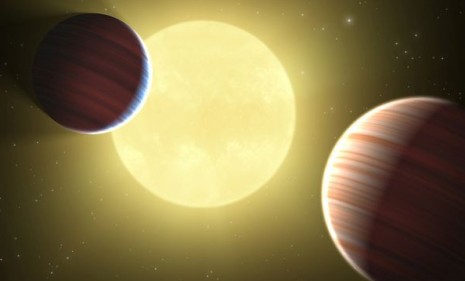What is 'super Earth'?
Scientists have discovered a planet only slightly larger than the Earth orbiting a distant star. Could it host life?

Scientists have made two fresh discoveries of multiple planets orbiting the same star outside of our own solar system. NASA's Kepler Space Telescope has discovered three planets orbiting the same star, including one almost the same size as our planet. It's this last celestial body, nicknamed "super Earth" that has grabbed the most attention. Here's a quick guide:
Where are these planets?
In the Lyra constellation, 2,283 light years away from Earth. Two are Saturn-sized planets — around 65 times more massive than our Earth — and the third is what scientists have branded a "super Earth." All three are extremely close to one another.
The Week
Escape your echo chamber. Get the facts behind the news, plus analysis from multiple perspectives.

Sign up for The Week's Free Newsletters
From our morning news briefing to a weekly Good News Newsletter, get the best of The Week delivered directly to your inbox.
From our morning news briefing to a weekly Good News Newsletter, get the best of The Week delivered directly to your inbox.
Why is the "super Earth" worthy of note?
Because it's almost the same size as our own planet — just 50 percent larger. If confirmed, it would be the smallest planet yet discovered outside of our solar system and the closest thing we have found to a "twin" of Earth.
What do you mean, "if confirmed"?
The data is still slightly unclear. The Kepler telescope detects celestial bodies by tracking changes in light from stars as the planet passes in front of them. But a dimming of the light may not necessarily be a planet — nearby stars can cause fluctuations in a star's brightness.
A free daily email with the biggest news stories of the day – and the best features from TheWeek.com
Let's say this is a real planet. Could it sustain life?
It is highly unlikely. The planet is extremely close to its sun, orbiting it once every 1.6 Earth days. The surface temperature would consequently be around 3,500 degrees, making it incapable of sustaining water and therefore life as we know it. It's likely to be little more than a "barren target for intense radiation," says Pete Spotts at the Christian Science Monitor.
Is this the only multi-planetary system we know of?
No. In fact, another has been found by the European Southern Observatory in Chile. This system is just 127 light-years away, and could contain up to seven planets. Five are between 13 and 25 times the mass of Earth — similar in scale to Neptune — one is Saturn-sized, and a smaller, unconfirmed planet may prove to be another super-Earth.
How many planets outside our own solar system are we aware of?
As of last week, scientists have discovered 490 planets, including 45 multiple planet systems. Expect this number to increase: The Kepler telescope has discovered more than 700 "candidates" for planet status.
Could any of these sustain life?
Of course — theoretically. "Mankind has been asking the question, 'Are there other planets out there? Is there other life out there?' for thousands of years," Kepler scientist William Borucki told reporters. "In the next few years we'll have the answers to some of these questions."
Sources: Christian Science Monitor (2), Time, Wired
-
 How to financially prepare for divorce
How to financially prepare for divorceThe Explainer Facing ‘irreconcilable differences’ does not have to be financially devastating
-
 Why it’s important to shop around for a mortgage and what to look for
Why it’s important to shop around for a mortgage and what to look forThe Explainer You can save big by comparing different mortgage offers
-
 4 ways to save on rising health care costs
4 ways to save on rising health care costsThe Explainer Health care expenses are part of an overall increase in the cost of living for Americans